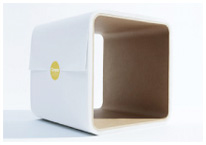FROM CONTEST TO MARKET

The structure serves as a sort of table,
providing a stable surface on which to write and draw.
The most important thing is to give anything a try
Trial and error is now under way to commercialize the "roll table", which won the grand prix in the KOKUYO DESIGN AWARD 2011 contest. This report describes the commercialization process.
In this third report, we talk with Factory Manager Shimohara of Daiki Shiko, who is attempting to roll sheets of paper onto the roll table. We asked him how he overcame the difficult problem of rolling a paper sheet onto a square block.

Factory Manager Shimohara
Daiki Shiko Co., Ltd.
"I had always been looking for something different, something interesting in my job", said Mr. Shimohara with a smile. As the president of Daiki Shiko, a company that cuts base paper for bags and wrappings, Mr. Shimohara is perpetually striving to do something new. One day, he received an interesting inquiry about commercializing the roll table. "Of course I was interested. At first, I thought it was something like cutting thin paper into small pieces. "But as he listened further, he realized that it was about rolling paper onto blocks with four square surfaces. "The base paper is rolled circularly, so I thought it would be impossible to roll paper onto a square block with the existing machines I had." What could he do? Suddenly, inspiration came; he remembered one machine he had once bought for his hobby.

Mr. Shimohara checks the rolling
"Most of the work is done automatically with our existing machines. But that old machine could be set manually in detail. When you roll a sheet on a cylinder, you only need a certain constant tension. But if you roll it along something with a square cross section, you cannot roll it neatly with constant tension, as the movement jerks. I tried again and again, making fine adjustments and searched for the most suitable position," explained Mr. Shimohara about how he tackled this difficult problem of rolling base paper onto a square block whenever he found time.
"When I saw a roll table for the first time, I thought it would be difficult to make the spindle. But I felt I should be able to roll the paper somehow, if I could make the spindle." The spindle is the wooden mold which fits inside the roll table. He drilled a hole in the center of this wooden mold, put the bar of the machine through it and rotated it. But unless the spindle and the roll table fit perfectly, the rotation becomes ragged and the paper cannot be rolled evenly. There was a gap between the spindle and the roll table when KOKUYO brought it in at first. He filled it with paper and rolled the base sheet to avoid rattles. The axis has been improved repeatedly and now the rattling has stopped. "Now that KOKUYO has made the perfect spindle, how could I be defeated?" Mr. Shimohara was not going to give up.

People of Daiki Shiko
who kindly cooperated with this trial production
Tests to commercialize the roll table started last winter, and now that summer has come, he says he can finally visualize completion. "The rolling process has almost been completed. Tension adjustment is no problem. But if the fine adjustment was even slightly off, it would have failed and I would have to have started from scratch again. It was an intractable problem, and it scared me (laugh). "After so much trial and error, now he feels a sense of achievement. Commercialization of the roll table is only possible because Mr. Shimohara has a challenging spirit and he had an old machine that he had bought for his hobby. "I learned much through this effort. The technology to adjust the tension, in particular, has improved greatly. I found it is important to give anything a try." Mr. Shimohara brimmed with the confidence gained from this accomplishment.

























